Chives are a magnet for pollinators with their nectar-rich flowers. They’ll attract endless beneficial pollinating insects and repel those less than helpful ones with their strong masking scent.
Chives are a versatile and easy addition to your vegetable garden, becoming a perfect companion plant and a go-to garnish for full-on flavour. Here we will show you just how effortless they are to grow in Australia and how they can benefit your garden and your plate.
More...

Family: | Amaryllidaceae |
|---|---|
Genus: | Allium |
Species: | A. schoenoprasum |
Common names: | Chives |
Origin: | Europe, Asia, and Russia |
Location: | Outdoor/indoor |
Type: | Perennial herb, edible, flowering plant |
Growth: | Up to 50cm tall. Clump forming. |
Sun requirements: | Full sun |
Foliage colour: | Green |
Flower colour: | Pink, Purple or white |
Flowering: | Spring to Autumn |
Edible parts: | Leaves, flowers and bulbs |
Maintenance level: | Low |
Poisonous for pets: | Toxic to all pets and livestock |
What are Chives?
Chives can often be mixed up with scallions, salad onions, green onions or even shallots. They’re all in the same family, and they’re all delicious but chives (Allium schoenoprasum) have a certain charm and functionality in ornamental borders and edible ones.
Some people think chives are the tops of onions, trimmed off while young. This isn’t the case. Chives are an herbaceous perennial that forms a small bulb underground. That makes it possible for them to produce leaves and come back year after year.
Chives can be tossed in a creamy potato salad, sprinkled on soup as a garnish or mixed in a delicious omelette. This milder-tasting member of the onion family is one of the most popular herbs we use today. That mild flavour is one of the reasons why chives are so loved.
Chives Plant Features
Chives grow to around 30-50cm in height, forming clumps of grass-like leaves. From these clumps will shoot a flowering scape which, similarly to the leaves, is also hollow and tubular. The flowering scapes are taller than the leaves and can be stiffer and stronger than the rest of the plant.
Flowers begin tightly hidden under a papery bract, which peels away as the flowers grow and swell. The inflorescence is pale purple to almost pink, each flower being star-shaped with 6 pointed petals. A faint darker line can be seen on the petals running through the centre.
Chive flowers are densely packed, between 10 and sometimes up to 30 held on one individual inflorescence. Once the flowers are pollinated and spent, they fade to an antique white and dry up producing dark black seeds, typical of the Allium family.
Leaves feel soft, smooth and almost rubbery when grown in a clump. When bruised or cut, chive leaves release a sweet and unmistakably oniony scent.
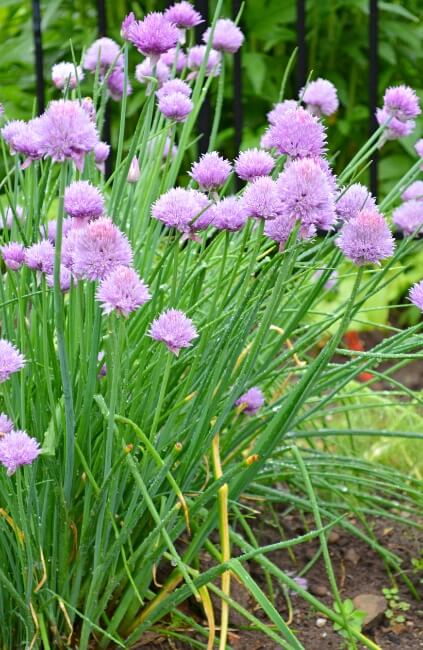
What is a Chive’s Natural Habitat?
Chives are native to temperate climates and are known to have been grown by many different ancient cultures. They are believed to be native to temperate parts of Europe, China, North America and parts of Russia.
Their self-propagation is so successful that it can be hard to tell where they originate from. Many colonies of ‘wild chives’ can be seen close to habitation and are most probably self-seeded cultivated chives.
Chives are herbaceous perennials so will come back every year after a period of winter dormancy. Therefore chives won’t grow well in warmer countries where they won’t have that dormant period, and often have to be grown as annuals in some parts of Australia.
Wild chives can be found growing and naturalising in a wide range of habitats as they’re really quite adaptable, but their preference would be to a situation with a little more free moisture available.
Common Uses of Chives
Having been cultivated for thousands of years, chives have a deep-rooted significance in many cultures. Chives also have a rich history of medicinal and anthropological use.


Get Your Free Guide:
Master Growing Australian Natives eBook
A Must Have Complete Guide for Every Australian Garden
Get Your Free Guide:
Master Growing Australian Natives eBook
A Must Have Complete Guide for Every Australian Garden
Cultural uses
Apparently, ancient Romans believed chives would make their horses and workmen stronger; the strength of flavour in chives would manifest a physical strength after being eaten. Chives were also eaten to cure sore throats and bodily pains.
In ancient Siberia, chives were used as an aphrodisiac, and regularly given as gifts to the gods. And in Europe, bunches of chives were hung up high to ward off evil spirits.
Garden uses
Their insect-repelling ability is just as good as their evil spirit-repelling ability and is put to good use in a vegetable garden, tactfully planted around vulnerable plants. Chives contain sulphur compounds which give them their smell and taste and help ward off pests. Luckily it doesn’t ward off the good ones!
They look good in an ornamental border too, as chive blossoms are amongst the prettiest flowers you can have for a naturalistic floral display. Chives have even been used as a mini hedge, planted densely to form a formal and functional partition.
Edible uses
Last but by no means least, chives are delicious in a plethora of dishes. Often added to creamy, rich sauces to give another layer of flavour. Chives can be added to dips or used as a delicious crumb topping blended with oils and nuts on fish or meat dishes.
The Best Varieties of Chives to Grow in Australia
The most used chives are the common chives (Allium schoenoprasum), but there are other varieties each with their own different flavours. These include the very decorative but still edible Siberian chives (Allium nutans) and those that have a unique flavour profile like garlic chives (Allium tuberosa).
All members of the Allium family (Amaryllidaceae) produce pom-pom-like flowers consisting of lots of little clusters of flowers. This is why chives are so pollinator-friendly.
They have unique, tubular, hollow leaves that are thin and delicate and add a zing to whatever they accompany.
1. Common Chives (Allium schoenoprasum)
Common chives are by far the most versatile and the most widely available to buy in both plant and seed form. With light purple flower heads, common chives perform well in the garden and are adaptable to most situations.
They are hugely beneficial to wildlife, attractive and complimentary to decorative borders, and help to balance your garden's ecology.
2. Serbian giant chives (Allium ledebourianum)
Serbian giant chives are an Asian variety of chives, native to Asia and Russia. They originate from the highest summit in the mountains of Serbia and are extremely hardy.
Perfect alliums for growing in high elevations. Their fragrant leaves are a beautiful glaucous colour. When planted en masse, Serbian giant chives’ soft pastel colourings are a delight.
3. Garlic chives (Allium tuberosum)
Garlic chives are a bulbous herbaceous perennial native to the Chinese province Shanxi and naturalised elsewhere and around the world. They have strap-shaped leaves, triangular at the base, and a distinct sweet garlic flavour; more garlicky than chive-like.
Flowers are white with an open habit resembling more of an umbel.
4. Siberian chives (Allium nutans)
Siberian chives are highly decorative with a good-sized open, spherical flower. Sometimes the pale pink/purple flowers come out as almost white. Native to Siberia and Asia and known as blue chives, Allium nutans have edible garlic-flavoured bulbs and mild-tasting leaves.
How to Grow Chives in Australia
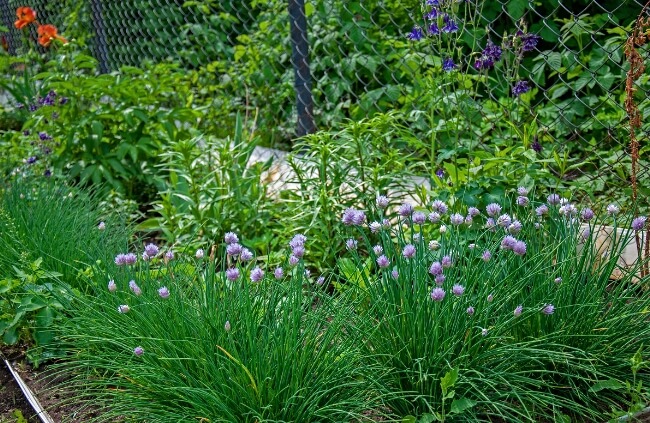
Being a herbaceous perennial, chives want to die back in winter. They naturally self-seed and multiply their bulbs underground which is the plant’s way of propagating itself, but they do need a period of dormancy throughout the colder seasons.
Without this chives will become weak and eventually die off. If you are growing chives in a warmer climate, your chives may be best treated as an annual and re-sown every year.
How to Propagate Chives
Chives are far better than gardeners at propagating themselves. Once you introduce them to your garden, they’ll happily multiply for you. But if you want to give nature a helping hand, or are growing from seed, here are a few simple steps to help you grow your own chives.
Propagating Chives from Seed
Growing chives from seed is a simple, inexpensive, way of creating lots of plants. Generally, chive seeds are fairly cheap and packets can have over 200 seeds - enough for a full garden if you’re patient.
You can also harvest some ripe seeds from existing chive plants when the flowers fade and dry. Seeds are held inside each chive flower within the globe-shaped inflorescence.
They will be dry when the flower looks white and has lost its colour. Snip off a chive flower head and sprinkle the black seeds into your hand or an envelope.
A good way of growing from seed is to use good-sized cell trays (5cm cells are ideal as they won’t dry out as quickly).
- Fill your cell trays with peat-free seed compost and tap down to fill any removed air pockets.
- Sprinkle your chive seeds into each compartment with a good pinch of seeds. The reason for sowing several seeds into each cell is to give a bushier plant.
- Keep your chives well watered and avoid letting them dry out.
- Place your tray in a warm and bright environment.
- Seedlings should appear within 2–3 weeks in which time you can re-sow again if germination is sparse.
- Once your chives are mature enough, they can be planted out and even gently divided if they are too thickly germinated.
- Each seed will produce its own chive leaves and you’ll get a thicker clump which can be divided when in its second year.
Chive seeds can also be sown directly with good results.
Chives Propagation from Division
Dividing your chive plants is another easy way of creating new plants and helping your chive patches to spread and thrive. If you have bought a plant to divide, simply tease the roots apart until you have segments of the plant with enough root to support the foliage of each section. This could be in half, quarters or even more.
Making sure there is still a good amount of root for each division, and replant these into the ground or into individual pots to grow on.
Division from ground-planted chive plants is just as easy. Using a fork, gently tease up clumps of chives from their roots, being careful to avoid damaging any bulbs. Removing some clumps for planting elsewhere or potting up to grow on will reinvigorate the original plant also.
Chives will produce ‘daughter’ bulbs which sprout off the mother bulb over a few years. These will throw up their own shoots and can be what you dig up to divide.
Ideal Conditions for Growing Chives
Let’s take a look at the sort of soil, light and temperature conditions that really make chives grow like crazy.
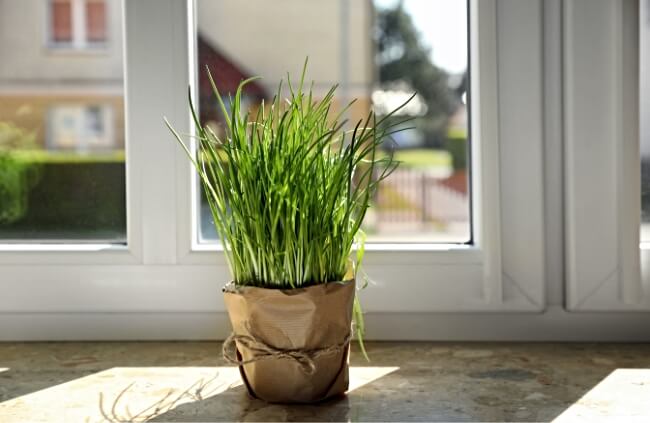
Soil & Drainage
They perform at their best in well-drained but moist soil, but chives will adapt to whatever environment they have. If you provide your chives with plenty of organic matter in your soil, this will help to retain the moisture they need and speed up growth and spread.
Chives prefer neutral to slightly acidic soil that has good drainage. Their efforts towards growing a healthy bulb will ensure their success in the next year, so planting in heavy clay or overly moist areas can hinder or even kill the growing bulbs.
Light & Temperature
The best possible position for your chives would be in full sun. However, they tolerate semi-shaded parts of your garden. Too little sunshine can stunt the growth of chives, particularly newly planted clumps.
With chives being temperate-loving plants, their sweet spot is neither too cold nor too hot. This is for optimum growth as chives are fairly hardy and adaptable and can cope with fluctuations. But once cold winter weather arrives they will begin to die back.
Shelter
Chives don’t particularly need much shelter, and often they provide their own support by growing in a dense and clump-forming way. You may find that singular, immature plants can often become a bit bedraggled by step winds but they’ll soon recover. And there’s no need to provide any winter protection as they need the cold for dormancy.
Planting Chives
Beyond choosing the best spot for your chives, the only planting preparation they need is some added compost and a little bit of drainage to keep them happy. If you find that your ground is lacking in nutrients, an occasional feed will keep your chives multiplying and constantly producing new, fresh leaves.
Chives Companion Planting
Chives are the ultimate companion plant, almost everything wants to be planted alongside chives. Their natural ability to refer pests and attract beneficial pollinators makes them the perfect partner plant for all sorts of common veggies.
The only plants that may not like being grown next to chives are legumes. Chives can inhibit the growth of legumes as they emit a substance that stunts the uptake of nitrogen, which is essential for healthy beans and peas.
Chives are particularly useful companion plants for brassicas, and despite some challenges growing alongside legumes, are still worth planting in containers nearby to deter aphids.
Caring for Chives
Luckily, chives practically look after themselves, but occasionally they require a little extra TLC.
Watering Chives
Water chives in hot, dry weather. If their bulbs dry out then your plants may not come back next year. Keeping them well watered will ensure plentiful harvests of your chives throughout the summer and into winter, and for years to come.
How to Prune Chives
Occasionally you may need to do a little aesthetic prune to your chives if they have developed some dry tips. Trimming back to the green will tidy up the plant and strengthen those hollow stems.
Harvest pruning is slightly different. There are several theories on how to prune your chives for the health and longevity of your plant. However you cut your chives, they will grow back.
Some people prefer to cut around the circumference of the plant to create a nicer shape. Others like to harvest in clumps. Even if you trim your plants all the way to the ground, they will shoot back up with fresh foliage.
My favourite method is to trim half the plant. This gives the best of both worlds, allowing one side to flower and producing new growth on the other.
Repotting Chives
Gardeners who are short on space or want to control chives’ spread may prefer to grow them in a pot permanently. Chives will happily grow in containers but may need repotting if they reach the edge.
Repot chives into a slightly bigger pot with peat-free compost and added drainage. Alternatively, you can divide your plant and only pot half back into the original pot, with newly added compost. Then either harvest the rest or compost it.
This way you can control the size of your chives and give yourself some fresh, tasty leaves for your next kitchen creation.
Chives’ Winter Care Requirements
In cooler, temperate parts of Australia, there’s no need to provide any winter care for chives. They have an annual dormancy period triggered by shorter days, causing them to die back naturally to the bulb each year. The same bulb will sprout again the next year, and multiply too.
However, if you’re one to forget where things are planted in winter, it can be helpful to place a marker in the ground to remind you. Your chives wouldn’t thank you for placing a big pot right on top of the ground, or accidentally digging them all up during another task.
How to Harvest and Store Chives
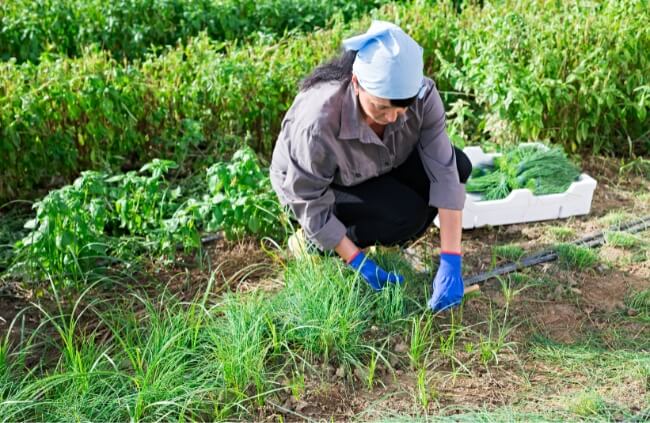
You can harvest chives at any time of the year so long as the plants are actively growing. If your chives are still young, hold off on making big harvests until they’re established enough to grow back.
Harvested full-length chive leaves will store in a refrigerator for up to a week and maintain crispness and flavour. The more cuts made to your leaves, the less well they’ll store.
Chives can also be frozen for future use. Chop into centimetre lengths and lay on a tray, place into a freezer and once completely frozen, collect into a container and place in the freezer. These can be used straight from the freezer as a garnish over hot food as they thaw out and keep that fresh green zingy flavour. Or tossed into the meal at the end of cooking will gently cook the chives.
You can also blitz chives into a paste for use in chive pesto or adding to bases whilst cooking. This is a good technique when you harvest a glut and have little space for storing!
The leaves and flowers from your chives are all delicious and I find the flowers have a much stronger flavour than the leaves. Separating the individual flowers and scattering them like a garnish will add colour and flavour, a little goes a long way.
Common Problems When Growing Chives
Overwatering and underwatering can both be the silent killers of chives. If your chives begin to develop dry tips and browned-out stems, they may need a good drink to rehydrate.
On the other hand, overwatered chives can show as yellowing and limp leaves that have just given up on life. Test the soil and allow it to dry out before watering again alongside checking the plant has adequate drainage.
Pests
Although chives are one of the best plants for deterring pests, they can occasionally take one for the team and fall victim to an attack. On the plus side, when your chives have a pest problem it’s normally not fatal.
Here are some of the unwanted visitors that you may find on your chives and how to spot and treat them.
Leek Moth (Acrolepiopsis assectella)
Although the leek moth typically targets leeks, they are known to visit all alliums including chives. The leek moth larvae bore into the leaves or bulbs and feed on the plant's tissue. Small holes covered by only the leaf’s epidermis and fallen flowers can be seen throughout.
Prevention involves covering plants with mesh to stop the moth from laying eggs, and vigilant removal of any visible larvae or cocoons.
Allium leaf miner (Phytomyza gymnostoma)
The larvae from the leaf miner fly can feed within the leaves of chives. The female moth also sucks sap from the leaves before laying eggs causing distinctive lines of white dots on foliage. Damage caused by leaf miners is similar to that of leek moth, also causing distorted twisting growth in leaves.
Often secondary infections are caught due to open wounds which cause plants to rot. Again, covering and tenacious removal of any visible pupae will help to prevent damage.
Onion fly (Delia antiqua)
The larvae from the onion fly will feed on plants in the allium family and cause large cavities in the bulb. Plants start to yellow and rot quickly. Larvae are white and pupae are brown. Again, vigilant removal of any visible maggots will help lessen the damage.
As the pupae can overwinter, crop rotation will help, lifting chives and changing the compost along with dividing plants and repotting away from the original. Autumn digging of the ground can help destroy the overwintering pupae.
Diseases
Two common diseases can and do affect chives in Australia; leek rust and downy mildew. Both are exacerbated by damp, humid conditions and poor ventilation.
Leek Rust (Puccinia porri)
This fungus mainly affects leeks but can affect all alliums, including chives. Leek rust is caused by a fungus that leaves bright orange to yellow pustules on the leaves resembling rust patches. These pustules can break open to release spores spreading to other plants.
Maintaining good airflow is a good way of preventing all fungus. This can be done by lifting and separating densely grown chives. Also, fastidious removal and disposal of all infected plant debris is a useful way to reduce recurrence.
Downy Mildew (Puccinia destructor)
Downy mildew can be seen as greyish pale fuzz on the leaf's surface. Leaf tips will die back and show yellowing throughout. Downy mildew is caused by a fungus, so the treatment is much the same as above.
Removal and disposal of all infected plant material, and practising good airflow between plants.
Chives Frequently Asked Questions
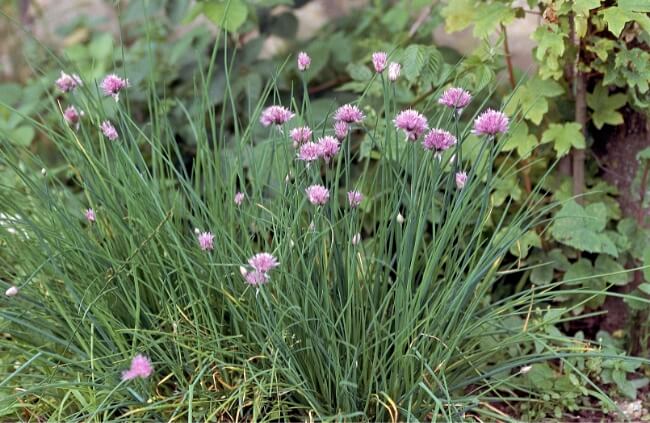
Are chives in the allium family?
Chives are a member of the allium genus, although there is some common confusion between their wider family. They are Amaryllidaceae but are often mistaken for Liliaceae.
Do chives come back every year in Australia?
Chives grow best with a period of winter chill and a wet, temperate cold season. In many parts of Australia, that means that chives don’t grow well after their first year and will need resowing, but if grown in heavily dappled shade, they can be a useful perennial crop.
How invasive are chives?
Chives are prolific self-seeders, and they spread efficiently through bulb division. However, they are not particularly invasive in gardens, and are very easy to manage. By digging up a clump of bulbs with their bases you can be sure they won’t come back as the bulb is the only part capable of regenerating.
Are green onions and chives the same thing?
Green onions and chives are not the same thing. They have different flavour, different leaf form, and different bulb sizes. They are also very rarely used as a perennial crop like chives, as the bulb is the most useful edible part of green onions.
Should I deadhead chives?
Deadheading chives, by cutting the flowering stalk right back to the ground will encourage more flowers, and also offer a powerfully flavoured garnish as the flowers can be broken up and sprinkled on salads.
Can dogs eat chives?
Dogs cannot eat chives. Chives are a member of the allium family and are toxic to dogs, cats, rabbits and most common pets. Japanese dog breeds and cats are particularly vulnerable to allium toxicity.
Why are my potted chives dying?
Chives like moisture, but not too much. A common mistake many gardeners make is to plant them with Mediterranean herbs in mixed containers. Each likes very different conditions, do keep chives in moist but not boggy conditions where possible.
Wrapping Up Our Chives Growing Guide
Their arrival signals the start of the growing season for vegetable enthusiasts. Chives are the cheerleaders of the garden, encouraging us with their dancing pom-poms and preparing us for the summer ahead.
Such a versatile and accessible crop to grow for beginners, chives are an excellent pathway into gardening. Or for the seasoned grower, an old friend that comes back every year. With their variations of flower and flavour, chives are fuss-free and so rewarding.
Published on July 1, 2025 by Maisie Blevins
Last Updated on October 4, 2025




